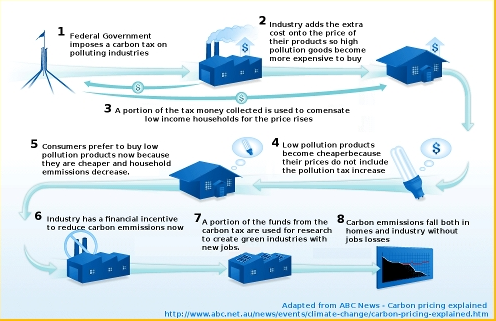Last week, I introduced the issue of negative externalities and how the amount that consumers pay for energy fail to reflect the environmental and social costs that come with its extraction and production. Recall that the supply curve typically shown in introductory economics classes only projects the Marginal Private Cost (MPC) of the firm, but there also exists a curve called the Marginal Social Cost (MSC), which gives a graphical representation of the external costs that come with the creation of a good. The gap between the MPC and the MSC must be closed for the sake of sustaining not only the global ecosystem, but humanity itself. The question is: how can we do this? One of the more prevalent methods used in government policy is called a carbon tax. A carbon tax is exactly how it sounds—a tax is placed on polluters that use fossil fuels, usually charged per ton, in an attempt to reduce the emission of carbon dioxide and incentivize innovations in cleaner energy. In economic terms, a polluter will pollute up until the marginal benefit (MB) of polluting (more output, cheaper facilities costs, etc.) equal the marginal costs (MC) of polluting. A carbon tax makes the marginal cost of polluting for every unit higher, which will ultimately decrease the amount that is polluted. An infographic that was made to promote carbon tax policy in Australia does a good job showing the effects of implementing a carbon tax on industries and explaining the incentive of green energy innovation:
Compared to other energy policies, such as the frequently compared cap-and-trade system (although they are actually very different…but that’s something that I’ll talk about more next week) carbon taxes are the most straightforward and transparent because it simply involves embedding price signals in currently existing markets. According to the IMF, potential revenue from implementing corrective carbon taxes could average 2.6% of GDP globally. This is a policy that every country in the world can do without global coordination, which is beneficial because global environmental policies tend to both lag and lack cooperation. A corrective tax could not only reduce CO2 emissions by 23% globally, but it could also reduce worldwide deaths from outdoor, fossil fuel, and air pollution by 63%. These may seem like lofty numbers, but in a world where a large portion of countries still depend on coal as their primary energy resource, the positive effects add up.
One of the most successful implementations of a carbon tax is that of Vancouver B.C.’s. Beginning in 2008, British Columbia began charging $10 Canadian dollars (about $9) per ton, and increased the tax by $5 per year until it reached $30 per ton in 2012. One major detail that is different from the description in the infographic above is that their tax is revenue neutral. Revenue neutrality is a taxing procedure where the government still receives the same amount of money despite the changes in tax laws. In Vancouver B.C., when the carbon tax was implemented, they offset this revenue by cutting income and corporate taxes. Although revenue neutrality isn’t ideal for many left-leaning environmentalists, revenue neutrality helps gain traction conservatives because it doesn’t add to government deficits. The effects of this carbon tax were quite substantial. Not only has per-person consumption of fuels dropped by 16% since the implementation (while the rest of Canada’s per person fuel consumption went up 3%), but British Columbia’s GDP per capita is almost .5% higher than the rest of Canada.
There are also many critiques of the carbon tax system. Firstly, it has proven to be somewhat difficult to “find the right price” of a carbon tax because of limited pollution measuring resources and lack of data. It is usually quite costly, and potentially economically inhibiting, if a government over or underestimates the tax. In addition, Thomas Pyle, president of the Institute for Energy Research, argues that tax swapping would make the tax code more inefficient because a carbon tax has a smaller base than an income tax. In the specific instance of British Columbia’s carbon tax, cement making firms claim to have lost a third of their market share to US and Asian imports. This brings up the issue of production shifting to countries with no carbon taxes. That being said, there is very little actual evidence that carbon taxing is directly related to jobs.
Currently, an initiative to implement a revenue-neutral carbon tax in Washington has been recently gaining a lot of traction. It is modeled very similar to British Columbia’s in the sense that the carbon tax will gradually increase in price from year to year up to $25 per ton of CO2, and it is revenue neutral. This tax will reduce the sales tax rate by one full percentage point, provide a $1500 yearly rebate for 400,000 low-income working households, and eliminate a business tax for manufacturers. For more information, here is their official website.
Next week, I will explain the cap-and-trade system and how it is different from a carbon tax. Although both a cap-and-trade and a carbon tax have the same endpoint, the way that they get there are substantially different. Stay tuned next Thursday!

